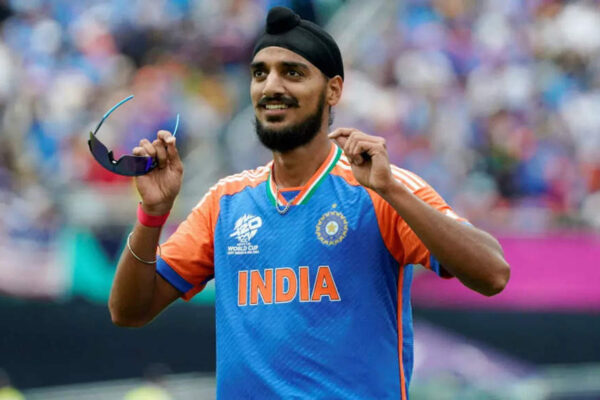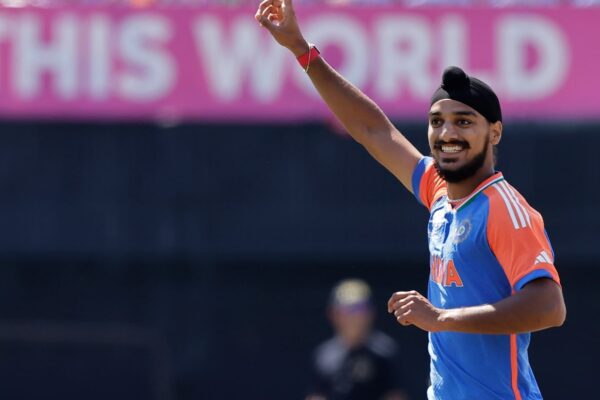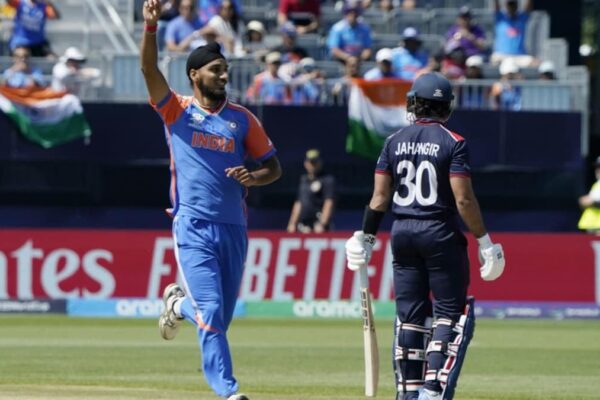Follow the ICC T20 World Cup 2024 live cricket score on Sports.NDTV.com. After 5.1 overs, India, chasing a target of 111, are 27/2. Get live score, ball by ball commentary and much more. Keep track of ICC T20 World Cup 2024 today match between USA and India. Everything related to USA and India match will be available on Sports.NDTV.com. Stay updated with USA vs India live score. Do check for USA vs India scorecard. You can get scorecard updates, match related facts. Get quick live updates with ads, Sports.NDTV.com, which is the perfect destination for live cricket score.
4.6 overs (0 Run)
Goes back to his fuller length, on off, Rishabh Pant pushes it to extra covers.
4.5 overs (1 Run)
On a length and around off, Suryakumar Yadav steers it to third man for one.
4.4 overs (0 Run)
Touch fuller and around off this time, Suryakumar Yadav keeps it out to the off side.
4.3 overs (2 Runs)
Back of a length and on off, Suryakumar Yadav punches it through covers for a couple of runs.
4.2 overs (6 Runs)
SIX! SKY at his best! Saurabh Netravalkar lands this on a good length, on middle, angling in, Suryakumar Yadav crouches low, uses his wrists well to scoop it away over the fine leg fence for a biggie.
4.1 overs (0 Run)
Full and on off, Suryakumar Yadav pushes it to short covers.
3.6 overs (0 Run)
Pulls his length back a bit, on middle, Rishabh Pant fends it out. Tidy over!
3.5 overs (1 Run)
Another full delivery, on middle, Suryakumar Yadav tucks it away to deep mid-wicket for one.
3.4 overs (0 Run)
Pitches it up, on middle, Suryakumar Yadav blocks it down the pitch.
3.3 overs (1 Run)
Back of a length and on off, Rishabh Pant guides it to third man for another run.
3.2 overs (1 Run)
Full again and on middle, angling in, Suryakumar Yadav flicks it through square leg for a run.
3.1 overs (1 Run)
Jessy Singh starts with a full delivery on the pads, Rishabh Pant clips it towards deep square leg for a single.
Jessy Singh is introduced into the attack.
2.6 overs (1 Run)
On a length and on off, Rishabh Pant runs it down to third man for one. End of another successful over from Saurabh Netravalkar!
2.5 overs (1 Run)
Overpitched and outside off, Suryakumar Yadav slices it on the bounce to third man for a run and gets off the mark.
Halt! The ball has stung Suryakumar Yadav’s right wrist and the physio is out in no time to treat the hurt area with the magic spray. He is being strapped now and is all well to continue.
2.4 overs (0 Run)
Hits the hard length this time, on middle, nips back in sharply, Suryakumar Yadav gets hurried a bit as the ball crashes onto his fingers. That will sting a bit!
2.3 overs (0 Run)
Pitched up, on off, Suryakumar Yadav taps it to short covers.
Suryakumar Yadav is in at number 4.
2.2 overs (0 Run)
OUT! TAKEN! Saurabh Netravalkar strikes again! He gets the Indian skipper this time and USA are pumped here. This is full again and on off, shapes away a bit, Rohit Sharma tries to flick it away but closes the face of the bat early, gets a leading edge as the ball flies behind mid off where Harmeet Singh keeps his eyes on the ball, backtracks a bit and takes a fine catch. India lose both their openers now!
2.1 overs (0 Run)
Fuller and around off, Rohit Sharma strides out and pushes it straight to short covers.
1.6 overs (1 Run)
Short of a length and outside off, Rohit Sharma cuts it away towards deep point for one.
1.5 overs (0 Run)
Another full delivery, on middle, Rohit Sharma blocks it out.
1.4 overs (1 Run)
Pitched up, on middle, Rishabh Pant tries to swat it past the bowler but fails to get the timing rigth as the ball rolls between mid on and mid off. They cross.
1.3 overs (1 Run)
Touch fuller, on middle, keeps a bit low, Rohit Sharma manages well to get bat on that and knocks it to mid on for a run.
1.2 overs (1 Run)
This is on a good length and on middle, shaping in, Rishabh Pant misses his flick as the ball goes off his pads towards square leg. They cross.
1.1 overs (4 Runs)
FOUR! You cannot bowl there to him! Ali Khan begins with a short delivery, outside off, Rishabh Pant gets the chance to free his arms, takes no half-meausres and crunches it over point for the first boundary of this chase.
Ali Khan to bowl the second over.
0.6 over (1 Run)
Goes full again, on leg, Rishabh Pant flicks it away towards deep square leg for a single. Just two runs and a huge wicket from the first over!
0.5 over (0 Run)
Pitches it up, on off, Rishabh Pant pushes it to short covers.
0.4 over (0 Run)
Oh…so close! Saurabh Netravalkar pulls his length back a bit, on off, nips back in sharply this time, Rishabh Pant gets squared up as he tries to play at it and misses, the ball just zips past the stumps.
0.3 over (0 Run)
Full again and on off, shaping away, Rishabh Pant steers it to point.
Rishabh Pant is in at number 3.
0.2 over (0 Run)
OUT! EDGED AND GONE! What a start for USA! Saurabh Netravalkar gets the big fish here as Virat Kohli walks back for a golden duck. This one is a bit fuller and just around off, angling away, Virat Kohli takes a half-stride and tries to drive away from his body, gets a thin outside edge behind where Andries Gous makes no mistake. Kohli’s barren run in this World Cup continues!
0.1 over (1 Run)
Rohit Sharma and India are underway straightaway! Saurabh Netravalkar starts with a back-of-a-length delivery around off, Rohit Sharma guides it…
















